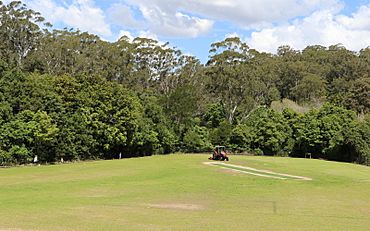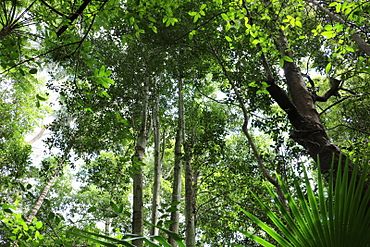Browns Field (New South Wales) facts for kids
Quick facts for kids Browns Field (New South Wales)New South Wales |
|
|---|---|
 |
|

rainforest at Browns Field
|
|
| Website | Browns Field (New South Wales) |
Browns Field is a cool spot in Fox Valley, Wahroonga, about 17 km north-west of Sydney, in New South Wales, Australia. It has a sports field and a bushland area. What makes it special is a unique rainforest that grows nearby. This rainforest thrives because the soil is super rich from ancient volcanic activity!
Contents
Amazing Ancient Volcanoes
Browns Field sits on a special type of ancient volcano called a maar-diatreme. Imagine a huge explosion that happened about 200 million years ago! This was during the time of the dinosaurs, in the early Jurassic period.
How the Volcano Formed
The volcanic explosion created a big crater, about 200 meters wide. It blasted right through the local Sydney sandstone. The soil here is very dark because it's full of volcanic minerals. Most of the volcanic rock is now buried under soil. Some of it was even covered when the sports oval was built. So, you won't see much rocky evidence of this ancient volcano today. But its rich soil helps special plants grow!
A Glimpse into History
For thousands of years, the local Indigenous Australian people, the Kuringgai, lived in this area. They were the first caretakers of this land.
European Settlement and Timber
Later, in 1822, a former convict named Thomas Hyndes settled nearby. In 1838, Governor Darling gave him a large piece of land. Hyndes used convict workers to cut down timber for the colony of New South Wales.
In 1854, the land was sold to John Brown. He was a merchant and also cut timber. He even planted fruit orchards nearby. People called him 'Squire Brown' because he owned a huge area of land. He employed many workers to cut timber. This timber was used for big projects, like building the Pyrmont and Glebe Island Bridges. The area that is now a sports field was once a native forest. Later, it was even used as a rubbish tip before becoming the field we see today.
Fun and Recreation
The oval at Browns Field is a busy place! It's used for different sports like football and cricket. If you love exploring, a bushwalking track starts right near the field. It's a great way to see the beautiful bushland.
Wonderful Plants
Browns Field is home to many amazing rainforest plants. Some of these are quite unusual for the Sydney area!
Unique Rainforest Species
You can find plants like golden sassafras, jackwood, scrub turpentine, and wild quince. There are also beautiful ferns like giant maidenhair, fishbone water fern, and strap water fern. The sub-tropical rainforest tree, the koda, also grows here.
This rainforest thrives because there are not many bushfires here. The dark volcanic soils and high rainfall also help. The area gets about 1400 mm of rain each year!
Amazing Animals
Browns Field is a great place to spot wildlife! You might see Ring-tail possums and brushtail possums. Grey-headed flying foxes are also common visitors.
Birds of Browns Field
Many different bird species live nearby. Look out for colorful rainbow lorikeets, Australian king parrots, and crimson rosellas. You might also hear currawongs, the koel, and see the camouflaged tawny frogmouth. The impressive powerful owl is even known to nest in this special reserve!
Helping Nature Grow
People are working hard to protect and restore the forest at Browns Field. This is called bush regeneration. They are trying to remove problem weeds like Tradescantia fluminensis (trad) and Ligustrum sinense (privet). These weeds can take over and harm the native plants.
Images for kids
-
A beautiful rainforest at Browns Field.




